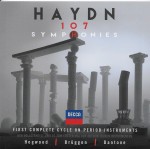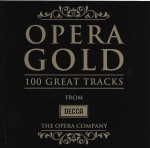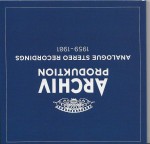Old Wine in New Bottles | Fine Recordings Re-Released - September 2016
 Last year Decca issued a 32-CD set of all the Haydn Symphonies that Hogwood and the Academy were able to finish before the project ended. To top that, Decca has issued another box, this one of the Haydn – Complete 107 Symphonies (4989604, 35CDs). This new set incorporates all the Hogwood performances plus recordings by Frans Brüggen directing the Orchestra of the Age of Enlightenment and also the Orchestra of the Eighteenth Century. Neither had set down the symphonies Nos.78 through 81.Decca selected the Accademia Bizantina conducted by Ottavio Dantone to provide them. This orchestra, managed autonomously by its guardian members, was founded in Ravenna, Italy in 1983 with the intention of “making music like a large quartet.” Recorded in 2015, their focus and totally unexpected energy comes as something of a shock as one plays through the set. If you wonder how the accepted 104 symphonies grew to 107 it is because of the inclusion of the “A & B” early symphonies and the Sinfonia Concertante in B-Flat major (Hob.1.105) from the same year, 1792, as the Symphonies 97 and 98. So here it is … the first complete edition of the historically informed performances of the 107 Haydn Symphonies employing “original” instruments. Yet, as performing music is not an exact science, each of the four ensembles is clearly different from the others, making the whole package all the more interesting.
Last year Decca issued a 32-CD set of all the Haydn Symphonies that Hogwood and the Academy were able to finish before the project ended. To top that, Decca has issued another box, this one of the Haydn – Complete 107 Symphonies (4989604, 35CDs). This new set incorporates all the Hogwood performances plus recordings by Frans Brüggen directing the Orchestra of the Age of Enlightenment and also the Orchestra of the Eighteenth Century. Neither had set down the symphonies Nos.78 through 81.Decca selected the Accademia Bizantina conducted by Ottavio Dantone to provide them. This orchestra, managed autonomously by its guardian members, was founded in Ravenna, Italy in 1983 with the intention of “making music like a large quartet.” Recorded in 2015, their focus and totally unexpected energy comes as something of a shock as one plays through the set. If you wonder how the accepted 104 symphonies grew to 107 it is because of the inclusion of the “A & B” early symphonies and the Sinfonia Concertante in B-Flat major (Hob.1.105) from the same year, 1792, as the Symphonies 97 and 98. So here it is … the first complete edition of the historically informed performances of the 107 Haydn Symphonies employing “original” instruments. Yet, as performing music is not an exact science, each of the four ensembles is clearly different from the others, making the whole package all the more interesting.
 There is a fine collection of “the most beautiful operatic moments” from Decca Records appropriately titled Opera Gold (4788210, 6 CDs). In a box only 5/8 of an inch thick are 100 tracks of superb renditions of all the familiar and some, perhaps, unfamiliar solos, duets and larger ensembles drawn from the treasured archives of English Decca. Decca documented so many of the great ones: Pavarotti, Horne, Sutherland, Freni, Tebaldi, Kaufmann, Bergonzi, von Stade, Nucci, Te Kanawa, Milnes, Ghiaurov, Tourangeau, Fleming and Corelli. Conductors include Mehta, Bonynge, von Karajan, Pappano, Molinari-Pradelli, Serafin and Solti. All are on the first of the six CDs. This elegant little black box with gold lettering would be a thoughtful and lasting house gift instead of wine or flowers to take to an invitation to a friend’s home. Shop around, it can be found for about $20.
There is a fine collection of “the most beautiful operatic moments” from Decca Records appropriately titled Opera Gold (4788210, 6 CDs). In a box only 5/8 of an inch thick are 100 tracks of superb renditions of all the familiar and some, perhaps, unfamiliar solos, duets and larger ensembles drawn from the treasured archives of English Decca. Decca documented so many of the great ones: Pavarotti, Horne, Sutherland, Freni, Tebaldi, Kaufmann, Bergonzi, von Stade, Nucci, Te Kanawa, Milnes, Ghiaurov, Tourangeau, Fleming and Corelli. Conductors include Mehta, Bonynge, von Karajan, Pappano, Molinari-Pradelli, Serafin and Solti. All are on the first of the six CDs. This elegant little black box with gold lettering would be a thoughtful and lasting house gift instead of wine or flowers to take to an invitation to a friend’s home. Shop around, it can be found for about $20.
 Since 2013 when DG issued Archiv Produktion 1947-2013 (4791045, 55 CDs) we have waited for a follow-up set which has now arrived, Archiv Produktion Analogue Stereo Recordings 1959-2013 (4791045, 55 CDs). As a background to Archiv Produktions we should go back to the spring of 1941 when all shares of Deutsche Grammophon were transferred to Siemens AG. Through the 1940s and the 1950s, under Ernst von Siemens, a music lover, the company became the industry leader in Germany and garnered international recognition. Siemens worked passionately, building a spectacular catalogue of impeccable performances of classical music that was supported to a large extent by the company’s catalogue of popular and dance music that was exported to other European countries. Siemens undertook to document Germany’s profound and lasting contribution to music and to do so, in 1947, the Archiv label was born. Bach, of course was the initial focus and the 40-year-old blind organist, Helmut Walcha was chosen to record the master’s works on the 1659 Stralsund Stellwagen Organ in the Church of St. Jacob in Lübeck. Appropriately, some of these very first recordings appear on the first disc of the first box. Sometime after the launch of the Archiv label it was brought to Herr Siemens’ particular attention that Archiv Produktions was not a profitable division for the company, to which he countered most emphatically that Archiv was not conceived as a moneymaker but to document and disseminate German culture. One is reminded of the MGM motto, Ars Gratia Artis.
Since 2013 when DG issued Archiv Produktion 1947-2013 (4791045, 55 CDs) we have waited for a follow-up set which has now arrived, Archiv Produktion Analogue Stereo Recordings 1959-2013 (4791045, 55 CDs). As a background to Archiv Produktions we should go back to the spring of 1941 when all shares of Deutsche Grammophon were transferred to Siemens AG. Through the 1940s and the 1950s, under Ernst von Siemens, a music lover, the company became the industry leader in Germany and garnered international recognition. Siemens worked passionately, building a spectacular catalogue of impeccable performances of classical music that was supported to a large extent by the company’s catalogue of popular and dance music that was exported to other European countries. Siemens undertook to document Germany’s profound and lasting contribution to music and to do so, in 1947, the Archiv label was born. Bach, of course was the initial focus and the 40-year-old blind organist, Helmut Walcha was chosen to record the master’s works on the 1659 Stralsund Stellwagen Organ in the Church of St. Jacob in Lübeck. Appropriately, some of these very first recordings appear on the first disc of the first box. Sometime after the launch of the Archiv label it was brought to Herr Siemens’ particular attention that Archiv Produktions was not a profitable division for the company, to which he countered most emphatically that Archiv was not conceived as a moneymaker but to document and disseminate German culture. One is reminded of the MGM motto, Ars Gratia Artis.
In the second box, enthusiasts will applaud the return to the catalogue of classic performances by Karl Richter and the Munich Bach Orchestra, the Loewenguth Quartet, Simon Preston, Ralph Kirkpatrick, Pierre Fournier, August Wenzinger, Karl Ristenpart, Marcel Couraud, Nikolaus Harnoncourt, Josef Ulsamer, Maurice André, Charles Mackerras, Fernando Germani, Michel Corboz, Edward Melkus, the Melos Quartet of Stuttgart, Jürgen Jürgens, Helmut Walcha, John Eliot Gardiner, Kenneth Gilbert, Jordi Savall and many, many others. The repertoire includes much Bach. Also of special particular interest are performances of Schubert’s Arpeggione Sonata played on an arpeggione by Klaus Stock accompanied by Alfons Kontarsky and 19 Weber Lieder sung by Peter Schreier with Konrad Ragossnig playing guitar. Also David Munrow leading the Early Music Consort of London in Music of the Gothic Era now complete on 2 CDs. That group, as some remember, included Christopher Hogwood playing harp and portative organ. The curiosity in the mix is Gong Kebyar playing Gamelan Music from Bali, sacred and dance music recorded in there in 1972. The sets have booklets with photos of the artists and recording data. The complete details of both sets may be seen on line at deccaclassics.com.
This second Archiv box contains only performances from 1959 through to 1981. Does this hint of yet a third box?


